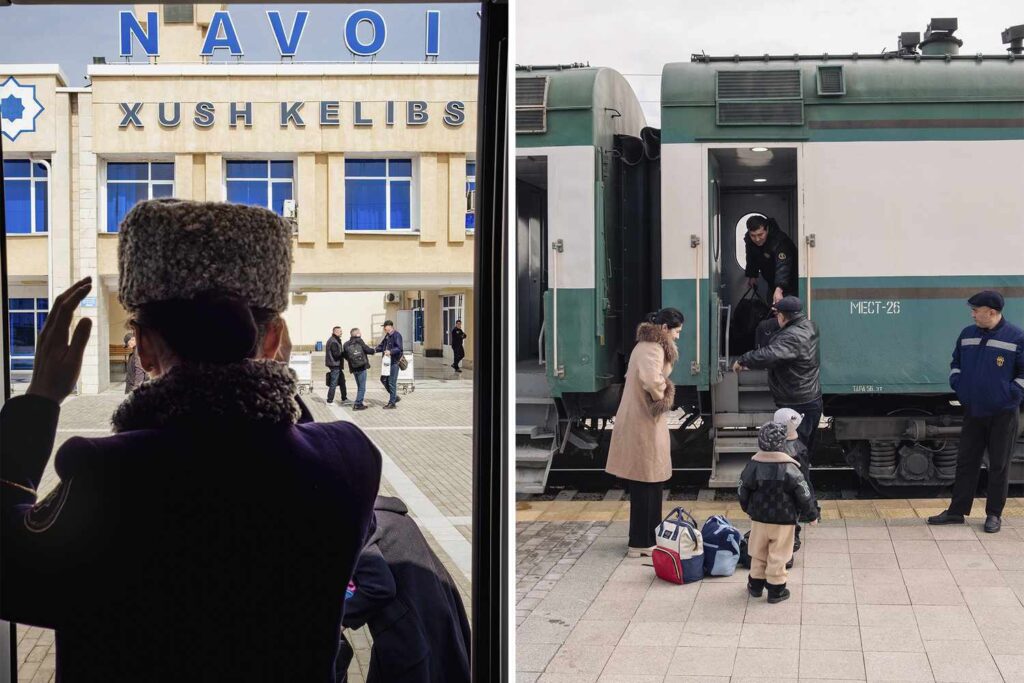The new trains in Central Asia will take you back to the past. As early as the second century B.C., an important network of trading routes known as the Silk Road linked Europe and East Asia. The first high-speed rail system in the region is being installed in Uzbekistan. This will make it easier for tourists to visit this part of route. Italian photojournalist Francesco Lastrucci switched between these new trains—which are on par with France’s TGV or Portugal’s Alfa Pendular—and the slower Soviet-era trains. He traveled from the capital, Tashkent, to Khiva—with stops in Samarkand, Uzbekistan’s second-largest city, and Bukhara. Lastrucci was surprised to find few English speakers and fewer tourists aboard the ship.
Francesco Lastrucci
Buy rail tickets à la carte at railway.uzJoin curated Silk Road tours, like this 17-day Silk Road Through the Caucasus tour with tour operator Abercrombie & Kent. Lastrucci tells the story of his three-day journey along the Silk Road. He also includes his recommendations for Samarkand Bukhara Khiva.
Francesco Lastrucci
Francesco Lastrucci
Day 1: Samarkand
“When arriving in Samarkand (a city in eastern Uzbekistan which was a major stopping point on the Silk Road), I headed straight to Registan Square. This is perhaps the most famous site in the entire country. As it began to rain, I went into Siyob Bazaar. It is a covered marketplace with two levels, where vendors sell food, pottery and spices. A woman was selling bread, which, in Uzbekistan, is round like a wheel—although the decoration changes from region to region. In Registan Square, there are three madrassas, or religious schools, including Tilla-Kari Madrassa, which is connected to an ornately decorated mosque. Then I took the fast train to Bukhara from Samarkand. Looking south I could see mountains bordering Turkmenistan in the distance. When we stopped in Navoi at a train station, I looked out the window and saw only locals.”
Francesco Lastrucci
Francesco Lastrucci
Day 2: Bukhara
“Bukhara’s hand-woven textiles and art are well known. I started my day at Bukhara Silk Carpets, in the city’s old town, which has a huge showroom and a workshop behind it, where I met about 20 kind, welcoming women making rugs. Many artists set up stalls near the entrance to the ancient Kukaldosh Madrassa. They painted Persian miniatures – small pieces of art with intricate details. Jam, the restaurant near the madrassa was the place where I had lunch. I tried the classic Central Asian dumpling pumpkin manti and the beef soup. My visit fell right before Nauruz, the Persian New Year; many locals were preparing for the celebration. “These women were dancing as they cooked sumalak – a sweet paste of sprouted grains.”
“The train from Bukhara was older than my very first train.” The desert landscape is the only thing between the two cities. Looking out over that vast expanse was like a meditation for me. When I got on the train, I was given a pillow and sheets and made my bed in the car, which I shared with three other people—two women, who only spoke Uzbek, and a university math professor who spoke English. We chatted the whole trip, and he even invited me for lunch at his house.”
Francesco Lastrucci
Francesco Lastrucci
Day 3: Khiva
Khiva is smaller than Bukhara. The main attraction is the unfinished Kalta Minor minaret, which I visited early in the morning to photograph. The freezing temperatures made it difficult to take pictures but I was glad that no one else was around. In the late afternoon, I had tea at Terrassa Café & Restaurant, which has breathtaking views over Ichan-Kala, Khiva’s Old Town. Away from the big crowds of Samarkand, my stay felt quieter, more intimate. I continued on to Paklavon Makhmud Mausoleum, the tomb of Khiva’s patron saint, which has a magnificent turquoise dome and a blue-tiled façade. Kuhna Ark citadel feels like a city within the city of Khiva. It was built in the 17th century by the khan of Khiva and is surrounded by fortified walls and watchtowers. I climbed one of them and found the best view of Khiva.”
Francesco Lastrucci


